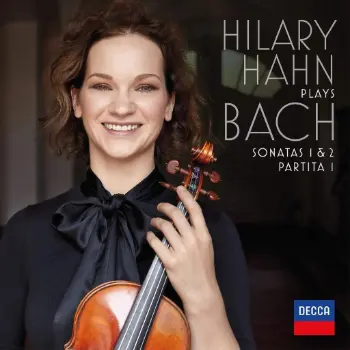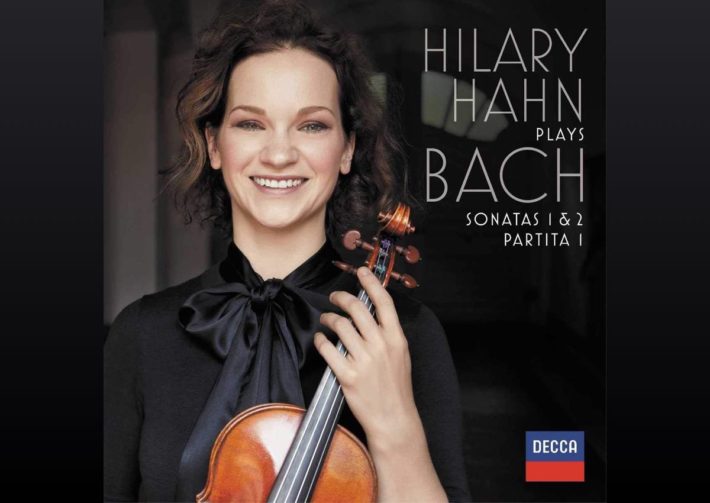It’s been 20 years since the then 17-year-old Hilary Hahn made a bold debut recording of Bach’s Sonatas and Partitas, and this later survey completes the whole cycle of solo Bach for Violin.

It’s rather interesting that a “modern instrument” Bach is pretty much a rarity these days, with most of the cycles incorporate baroque instruments and bows – The latest one by the well-respected period violin specialist Gottfried von der Goltz. If Hahn was influenced by the period movement’s practices, it’s not immediately apparent, nor was it so in her original 1998 release. It is a bold Bach, with shameless vibrato, broad tempi and not-so-subtle rubati. It’s now a rarity. And it’s very convincing.
Hahn opening of the First Sonata and the movement thereof represents the whole new album. Hear how the vibrato is omnipresent of the sound she produces, without sounding too plainly seductive. Or the final bars of the second, Fugue movement, where, very similar to the famous Menuhim version, she makes the coda an almost splashing showpiece. The slow movement is broad indeed, more measure than other modern instruments versions (Perlman, Grumiaux), but never missing in drive or tension. The final movement is a demonstration of how accomplished a violinist Hahn is technically, with not a hint of misses in intonation within this very difficult violin writing.
Unlike other performers, Hahn opens the First Partita’s Allemande subtly, in sharp contrast to the declamatory forcefulness of Perlman or Milstein. Here again, she opts for the slower side, but that works for the interpretation decisions. Where the tempo is perhaps more controversial is in the “double” second movement, which many interpreted as “double the measure”. Hahn here is one of the slowest in the catalog, but astonishingly similar to Menuhin’s 30’s version, in phrasing and tempo.
This is not to say Hahn lacks her own voice; The second double springs to life, again with an almost hard to believe accuracy, but hear how the small peeks of the phrases are crystal clear even in this tight and complexes movement. The Sarabande gives Hahn the chance to present her singing tone in its most velvety and penetrating. It’s a moving performance as any, one of the best tracks in this new album that I for one will go back to many times. But the magic doesn’t end there. Hear how naturally Hahn continues to the next “double” movement as if she is resurrected.
The Second Sonata is a tough piece to pull off, and especially in the first movement, which can sound dry and study even in the most capable hands, modern or period inspired. Here Milstein gave a masterclass of phrasing and sound shading, still hard to beat. Hahn chooses the leaner road, opting for a more modest, inward sound world than a projected display of beauty. Here again, her ending of phrases, bow work and masterful use of vibrato is in a class of their own, and it’s a joy to hear her voice leading in the Fugue that follows. Hahn declared her deep love for the Andante movement of this Sonata, and she regularly gives it as an encore in her concerts. Her performance here is heartfelt, almost literally beating with affection. It’s playing that penetrates by seemingly doing very little, a tough thing to achieve. The final Allegro finds Hahn in a dancing mood, finishing the album on a happy note.
Listening to this album continuously with the first 1998 release makes a compelling full Solo-Violin-Bach cycle. The original Sony recording was more resonant, but Hahn’s sound and way of handling the instrument haven’t changed much (for better or for worse). The new album incorporates two recording sessions made a couple of years apart, with Hahn picking what she felt was a better take. She also picked up a newer instrument than the one she used in the past two decades, but to my ears, there isn’t any hint of an inconsistency of sound or recording quality.
Comparisons are more complimentary to Hahn, with famous cycles from the past standing in this level of execution of these endlessly enriching works; Perlman and Grumiaux are similar in general style but more outwardly “romantic”, glissandi and all, than Hahn more restraint style. It’s Milstein that still has my vote for the best Bach full cycle in the catalog, but this new album will more than satisfy any Bach or Hahn admirer.
Bach – Sonatas No. 1 & 2, Partita No. 1 for solo violin
Hilary Hahn – Violin
Decca, CD B07DVGXNLP




















